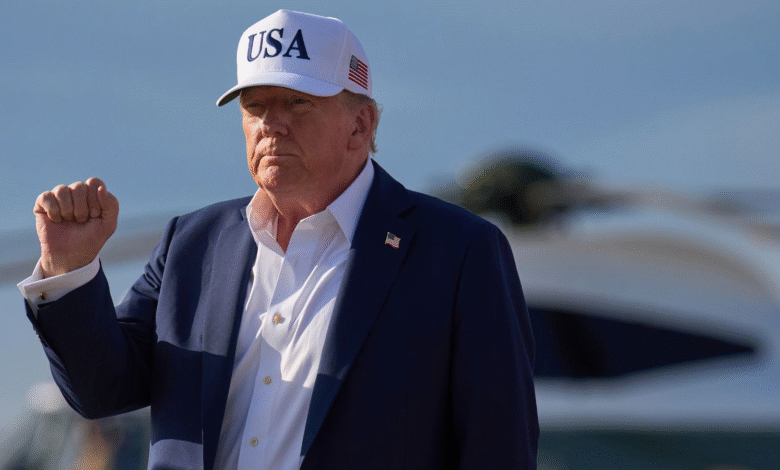US Tariffs Deadline: What You Need to Know by August 1

The US tariffs deadline has been firmly set for August 1, a critical date for countries facing new tariff rates imposed by the United States. Commerce Secretary Howard Lutnick confirmed during a CBS News interview that no country will be exempt from the deadline, emphasizing that negotiations can continue beyond this date, but tariffs will begin to accumulate on August 1. This signal of a hard deadline marks a pivotal moment in international trade agreements, especially for nations concerned about potential steep levies under the controversial policy introduced by President Donald Trump. With baseline tariff rates expected to start at 10% for smaller countries and possibly even higher for larger economies, the upcoming deadline is fueling increased discussions among partners eager to reach favorable terms before the tariffs take effect. As stakeholders brace for the implications of these tariff rates, the landscape of global trade continues to shift under the pressures of American economic policy.
As the clock ticks down to the US tariffs deadline, the implications for international trade are becoming increasingly pronounced. Nations are bracing themselves for the onset of potential tariff rates that could reshape market dynamics, with discussions around trade agreements intensifying in urgency. Under the direction of Commerce Secretary Howard Lutnick, countries are evaluating their positions in light of the stern reminders issued by the Trump administration about compliance with the looming deadline. With hints of tariffs soaring as high as 40% for certain trading partners, the stakes have never been higher for smaller nations wrestling with their economic strategies amidst changing regulations. Those involved in global commerce must navigate this evolving landscape, identifying opportunities to negotiate more favorable conditions before the August 1 cutoff.
Understanding the August 1 US Tariffs Deadline
Commerce Secretary Howard Lutnick has firmly established August 1 as the critical deadline for countries to commence tariff payments to the United States. This date signifies more than just a financial obligation; it represents a turning point in international trade relations. By setting this deadline, the US aims to reinforce its position in global trade dynamics, compelling nations to either adjust their approaches or face increased costs due to tariff rates. Lutnick’s stance that “nothing stops countries from talking to us after August 1” offers a glimmer of hope for diplomatic negotiations, suggesting that dialogue may still lead to trade agreements even as tariffs are enforced.
The implications of this deadline are extensive. Countries, particularly smaller nations, will need to strategically assess their trade policies in light of these impending tariffs. Initially, a baseline tariff of 10% is anticipated, but this could escalate significantly for larger economies that choose not to engage. This looming deadline has sparked significant discussions, as countries grapple with the urgency of responding to the US’s regulatory changes. Ultimately, how nations respond to the August 1 deadline could redefine their economic relationships with the US and shape their future trading strategies.
Impact of Rising Tariff Rates on International Trade
The new tariff rates proposed by the Trump administration are set to impose considerable challenges on international trade, particularly for nations heavily reliant on exports to the United States. Under the upcoming policies, some countries may face tariffs soaring up to 40%, a drastic change that could deter trade agreements and alter established commerce practices. Such abrupt financial burdens prompt nations to reevaluate their trade relationships with the US, potentially encouraging them to seek alternative markets or strengthen ties within existing partnerships.
Moreover, these increasing tariff rates have created an atmosphere of uncertainty, contributing to a ripple effect in global markets. Industries dependent on imported goods may encounter heightened costs, leading to inflationary pressures that affect consumers directly. As the deadline approaches, the sense of urgency to negotiate better terms intensifies. Countries are expected to initiate last-minute discussions to mitigate costs and reach mutually beneficial outcomes, showcasing the intricate dance of diplomacy in response to shifting tariff landscapes.
As illustrated by Secretary Lutnick’s latest remarks, the stakes are high for all involved, especially if larger economies find themselves in a position of needing to comply with the rising tariff rates or risk economic repercussions.
The Role of Commerce Secretary in Tariff Discussions
Commerce Secretary Howard Lutnick plays a pivotal role in shaping the United States’ tariff policies, acting as a key communicator between international trading partners and the Trump administration. His comments during interviews shed light on the administration’s stance and outline the expectations for trade negotiations. By publically addressing tariff rates and deadlines, Lutnick not only informs countries of their obligations but also sets the tone for potential negotiations post-deadline.
His insight into potential tariff rates for smaller nations highlights the administration’s strategy to prioritize opening trade routes while maintaining a strict regulatory framework. The call for countries to either engage in discussions or face considerable tariffs underscores the aggressive stance taken by the US in the realm of global trade. Lutnick’s role emphasizes not only commerce enforcement but also encourages a pathway for dialogue, demonstrating a blend of firmness with a willingness to negotiate, critical for maintaining future trade relations.
Navigating Donald Trump’s Tariff Policies
Navigating the complexities of Donald Trump’s tariff policies requires a nuanced understanding of the broader implications for international trade. Trump’s administration has been marked by significant tariff increases, which have sparked varied reactions from trading partners around the globe. The tariffs, surmised to be as high as 40% for certain countries, represent an aggressive tactic in reshaping the US’s trade framework and leveraging its economic power.
The approach taken by the Trump administration signals a departure from traditional trade practices, focusing instead on prioritizing American economic interests. Countries facing these tariffs must now recalibrate their trade strategies, balancing the need to remain competitive with the urgency to mitigate rising costs. Trump’s emphasis on negotiating favorable trade agreements while imposing strict tariffs highlights a dual strategy that seeks both compliance and dialogue, leading to a tense but potentially transformative trade environment.
The Future of Trade Agreements Amid Tariff Changes
As the US introduces new tariff rates, the future of trade agreements hangs in the balance, compelling nations to carefully reassess their trade relationships. The interplay of tariffs and negotiations could either strain international cooperation or pave the way for innovative agreements that accommodate the new economic realities. By setting a hard deadline for tariff implementation, the US is effectively guiding nations towards a critical juncture where they may need to pivot their trade policies.
The evolving landscape encourages countries to not only react to tariff changes but also to proactively pursue diversified trade partnerships. Smaller nations, in particular, must seek to collaborate and negotiate better terms to minimize the impact of tariffs on their economies. The discussions around trade agreements will have to incorporate the newly established tariff framework, requiring a strategic approach as countries navigate these profound changes.
Opportunities for Smaller Countries in the Tariff Era
While the looming tariff rates may seem daunting for smaller countries, there are potential opportunities arising from the new trade landscape. These nations could view the tariff deadlines as a catalyst for strengthening local industries and seeking new markets beyond the United States. By investing in domestic production and fostering innovation, smaller countries can reduce their dependence on imports and position themselves to thrive despite external pressures.
Furthermore, the potential for bilateral trade agreements presents an avenue for smaller nations to engage with other countries eager to explore new trade relationships. This situation may open doors to new trade dynamics that favor cooperation and strategic partnerships, allowing smaller nations to create alternative pathways for economic growth. In essence, while tariffs introduce challenges, they also inspire opportunities for nations to reimagine and bolster their trade strategies.
Last-Minute Negotiations Before the Tariff Deadline
In the face of the impending August 1 deadline, last-minute negotiations are taking center stage among trading partners anxious to circumvent heightened tariff rates. Countries currently burdened by uncertainty are racing against the clock, engaging in dialogues aimed at finding mutually agreeable terms before tariffs take effect. These negotiations reflect the high stakes associated with international trade and the necessity for adaptability to emerging economic policies.
The push for reduced tariffs or other favorable terms is likely to result in creative solutions and compromises that can ease the economic impact felt by both sides. As nations make concerted efforts to communicate and negotiate effectively, they demonstrate the resilience inherent in international trade relationships. The urgency surrounding these discussions underscores the delicate balance between enforcing trade regulations and fostering cooperative ties.
The Long-term Implications of US Tariff Policies
The long-term implications of the US’s evolving tariff policies extend beyond immediate financial consequences, impacting global trade dynamics fundamentally. As nations adapt to the changing tariffs, the potential shift in alliances and trading partners may emerge, reshaping economic landscapes for years to come. Tariff strategies that prioritize certain nations or sectors can lead to both economic isolation and a reevaluation of international collaborations.
Moreover, as countries grapple with the changes brought on by US tariffs, the necessity for robust economic planning and strategy will become increasingly important. Policy-makers will need to consider comprehensive approaches that encompass not just tariff rates, but also broader trade agreements and the leveraging of international relations to enhance economic resilience. The resulting shifts can redefine how nations interact in the global marketplace, influencing everything from supply chains to investment flows.
Lessons Learned from Tariff Implementation
The implementation of tariffs serves as a valuable lesson in international trade management, providing insights into the complexities of negotiating economic agreements. Nations that have faced the realities of rising tariffs must now reflect on their strategies, learning from the challenges and opportunities presented by the current landscape. Effective communication and negotiations are paramount in navigating this transformed trade environment, offering key takeaways for future interactions.
Additionally, the experience of adjusting to new tariffs reveals the necessity for agility in trade policies and the ability to pivot when faced with unexpected challenges. Countries that prioritize adaptive trade strategies and pursue cooperative negotiations will be better positioned to thrive amidst fluctuating economic conditions. Ultimately, the lessons learned during this period could serve as a blueprint for managing future tariff implementations and fostering resilient trade practices.
Frequently Asked Questions
What is the significance of the US tariffs deadline on August 1?
The US tariffs deadline on August 1 is significant because it marks the date when the new tariff rates come into effect for countries trading with the United States. Commerce Secretary Howard Lutnick has indicated that starting from this date, nations will begin paying these tariffs, which can range from a baseline of 10% for smaller countries to potentially higher rates for larger economies.
How have the US tariffs deadline and rates changed since Donald Trump’s initial announcement?
Since Donald Trump’s initial announcement on April 2 regarding tariffs, the US tariffs deadline and rates have evolved to establish a strict deadline of August 1. White House officials have confirmed that this date is firm, with new tariff rates set to be enforced on that day, contrasting earlier speculative rates that had been discussed.
What are the baseline tariff rates expected after the US tariffs deadline?
After the US tariffs deadline on August 1, smaller nations are expected to face a baseline tariff of 10%. Larger economies could encounter even steeper tariffs, as President Trump has hinted that rates could exceed 10%, with some nations facing tariffs as high as 40%.
Can countries negotiate tariffs after the August 1 US tariffs deadline?
Yes, countries can still engage in negotiations regarding tariffs after the August 1 US tariffs deadline. Commerce Secretary Howard Lutnick stated that while tariffs will start being enforced on this date, nothing stops countries from discussing terms or seeking reduced rates post-deadline.
What actions did President Trump take leading up to the US tariffs deadline?
In the lead-up to the US tariffs deadline on August 1, President Trump sent letters to trading partners outlining the new tariff rates and potential impacts. These communications indicated a baseline tariff for smaller nations and cautioned that larger economies might face even higher tariffs, signaling that negotiations could happen but under the looming deadline.
Who is Howard Lutnick and what is his role related to the US tariffs deadline?
Howard Lutnick is the Commerce Secretary who plays a key role in announcing and addressing the US tariffs deadline. He has clarified the implications of the August 1 date, asserting it as a hard deadline for tariff payments and outlining the expected tariff rates for different-sized economies.
What kind of tariffs can we expect after the US tariffs deadline for various nations?
Following the US tariffs deadline on August 1, smaller nations may encounter a baseline tariff of 10%, while larger economies could face significantly higher tariffs, possibly exceeding 10%. This could result in tariffs as steep as 40% for certain countries, as indicated by Commerce Secretary Howard Lutnick and President Trump.
Why are trading partners anxious about the US tariffs deadline?
Trading partners are anxious about the US tariffs deadline due to the uncertainty surrounding the new tariff rates and their potential economic impact. The firm deadline of August 1 has prompted last-minute negotiations, as countries seek to mitigate the effects of the tariffs announced by President Trump.
| Key Point | Details |
|---|---|
| Deadline for Tariffs | August 1 is the deadline for countries to start paying tariffs to the US. |
| Nature of Deadline | This is described as a ‘hard deadline’, meaning new tariff rates will take effect on this date. |
| Post-Deadline Negotiations | Lutnick mentioned that countries are free to negotiate with the US after August 1. |
| Tariff Rates for Smaller Nations | Smaller economies will likely face a baseline tariff of around 10%. |
| Tariff Rates for Larger Economies | Larger economies will either need to open trade or pay a fair tariff, potentially exceeding 10%. |
| Upcoming Communications | Trump indicates letters will soon be sent to smaller countries about expected tariff rates. |
| Potential Maximum Tariff Rates | Some nations could see tariffs as high as 40%. |
| Source of Information | This announcement was made during an interview with CBS News. |
Summary
The US tariffs deadline is set for August 1, marking a decisive moment for international trade relations. Commerce Secretary Howard Lutnick has confirmed that starting on this date, countries must comply with new tariff rates or face financial repercussions. This deadline emphasizes the urgency for trading partners to negotiate before tariffs are enforced, potentially impacting economies around the globe. Smaller nations can expect a baseline tariff of approximately 10%, while larger economies may be subjected to even steeper rates. As discussions continue, nations will need to act swiftly to mitigate the effects of these tariffs.




